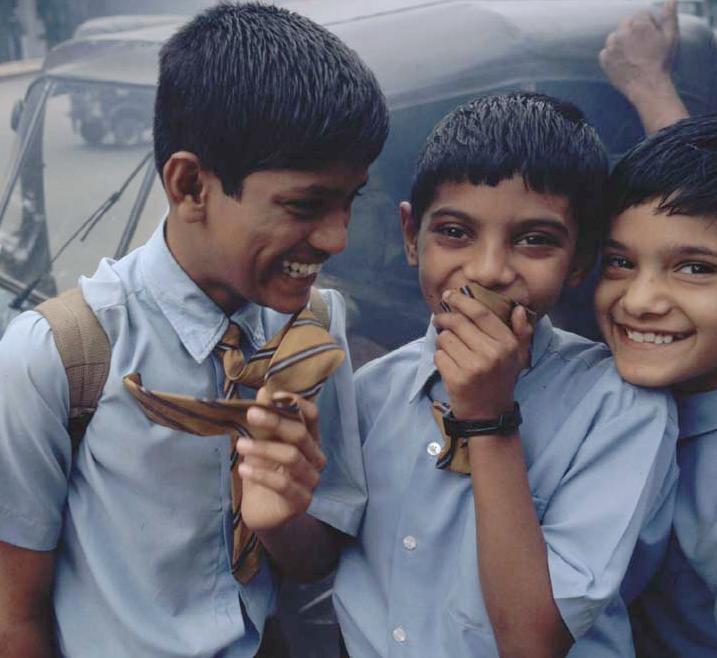
Indian Educational System: Private Schools

Figure 1.--There are some excellent private schools in India, but the state system is totally inadequate for the country's needs. These boys attend the Stracey Memorial High School for elementary and upper grade students. It is a private school in Bangalore.
|
|
In addition to the public school system, there are many private schools in India. These include many diverse schools. There are secular schools on the British model as well as a wide range of religious schools. Some schools have been founded by Christian churches are similar to the secular private schools with a modest religioys education component. Schools are also sponsored by the major Indian religious groups, espically Hindus and Moslems. These schools also vary. Some are associated with religion, but most of the curriculum is secular. Others are are traditional schools with religion at the heart of the curiculum. These traditional schools are commonly attached to temples and mosques. Some are run as Indian schools were for centuries. The Islamic schools are called madrasa and have been studied more than the Hindu schools.
The Hindu schools vary as to the caste group they serve. Some of the Hindu schools look similar to the secular schools. Others look like the schools that existed centuries earlier. We do not know a great deal about the curiculum. One source tells us that learn Hindu chants in the ancient language of India, Sanskrit. They are taught strict dietary rules, abstaining from eating meat and strictly vegetarian foods. History is an important part of the curiculm. The children are regaled with the legends of brave Hindu warriors and saints and learn about the ravages of the Muslim emperor, Babur, and subsequent repression by his discendents. We are not sure to what extent secular subjects are included in the curiculum or how state authorities may or may not regulate what is taught. A reader writes, "I suspect that the Indian Government requires some teaching about secular subjects, but the principal subject is the religion and especially the worship. The Brahmins are not monks and this is not an Ashram. They are priests and lead
the worship." Here we hope to obtain some detailed information from our Indian readers. Some observers believe that religion in India has become more militant in recent decades with religious identities becoming more divided and strident. As a result, the concern has been expressed that the religious schools are stoking the flames of Hindu nationalism and Islamic militancy.
Secular Schools
There are secular private schools, mostly on the British model.
Religious Schools
India has a wide range of religious schools. Some schools have been founded by Christian churches are similar to the secular private schools with a modest religious education component. For this reasons, the Christian afiliated schools are not just attended by Christian children. In contrast, Hindus would not attend Muslim schools and Muslims would not attend Hindu schools.
Schools are also sponsored by the major Indian religious groups, espically Hindus and Moslems. These schools also vary. Some are associated with religion, but most of the curriculum is secular. Others are are traditional schools with religion at the heart of the curiculum. These traditional schools are commonly attached to temples and mosques. Some are run as Indian schools were for centuries. The Islamic schools are called madrasa and have been studied more than the Hindu schools.
The Hindu schools vary as to the caste group they serve. Some of the Hindu schools look similar to the secular schools. Others look like the schools that existed centuries earlier. We do not know a great deal about the curiculum. One source tells us that learn Hindu chants in the ancient language of India, Sanskrit. They are taught strict dietary rules, abstaining from eating meat and strictly vegetarian foods. History is an important part of the curiculm. The children are regaled with the legends of brave Hindu warriors and saints and learn about the ravages of the Muslim emperor, Babur, and subsequent repression by his discendents. We are not sure to what extent secular subjects are included in the curiculum or how state authorities may or may not regulate what is taught. A reader writes, "I suspect that the Indian Government requires some teaching about secular subjects, but the principal subject is the religion and especially the worship. The Brahmins are not monks and this is not an Ashram. They are priests and lead
the worship." Here we hope to obtain some detailed information from our Indian readers. Some observers believe that religion in India has become more militant in recent decades with religious identities becoming more divided and strident. As a result, the concern has been expressed that the religious schools are stoking the flames of Hindu nationalism and Islamic militancy.
HBC-SU

Related Chronolgy Pages in the Boys' Historical Web Site
[Late 19th century]
[The 1930s]
[The 1940s]
[The 1930s]
[The 1940s]
[The 1950s]
[The 1960s]
[The 1970s]
[The 1980s]
Related Style Pages in the Boys' Historical Web Site
[Long pants suits]
[Knicker suits]
[Short pants suits]
[Socks]
[Eton suits]
[Jacket and trousers]
[Blazer]
[School sandals]
Navigate the Boys' Historical Clothing Web Page
[Return to the Main Indian educational system page]
[Return to the Main Indian school page]
[Introduction]
[Activities]
[Biographies]
[Chronology]
[Cloth and textiles]
[Clothing styles]
[Countries]
[Topics]
[Bibliographies]
[Contributions]
[FAQs]
[Glossaries]
[Images]
[Links]
[Registration]
[Tools]
[Boys' Clothing Home]
Created: 6:32 AM 1/29/2013
Last updated: 6:56 AM 1/29/2013




